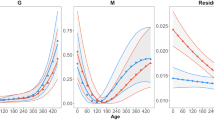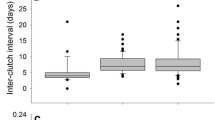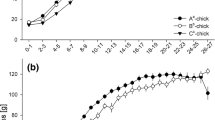Abstract
To understand how selection shapes life-history traits, we need information on the manner in which offspring phenotypes influence fitness. Life-history allocation models typically assume that “bigger offspring are better”, but field data paint a more complex picture: larger offspring size sometimes enhances fitness, and sometimes not. Additionally, higher survival and faster growth of larger offspring might be due to indirect maternal effects (e.g., mothers allocate hormones or nutrients differently to different-sized eggs), and not to offspring size per se. Alternative factors, such as seasonal timing of hatching, may be more important. We examined these issues using 419 eggs from captive jacky dragon lizards (Amphibolurus muricatus). The mothers were maintained under standardized conditions to minimize variance in thermal and nutritional history, and the eggs were incubated under controlled conditions to minimize variance in offspring phenotypes due to incubation temperature and moisture. We reduced the size of half the eggs (and, thus, the size of the resultant hatchlings) from each clutch by yolk extraction. The hatchlings were marked and released at a field site over a 3-month period, with regular recapture surveys to measure growth and survival under natural conditions. Growth rates and survival were strongly enhanced by early-season hatching, but were not affected by hatchling body size.




Similar content being viewed by others
References
Andrews RM, Mathies T, Warner DA (2000) Effect of incubation temperature on morphology, growth, and survival of juvenile Sceloporus undulatus. Herpetol Monogr 14:420–431
Brown GP, Shine R (2006) Why do most tropical animals reproduce seasonally? Testing hypotheses on an Australian snake. Ecology 87:133–143
Cogger HG (2000) Reptiles and amphibians of Australia. New Holland Publ, Sydney
Congdon JD, Nagle RD, Dunham AE, Beck CW, Kinney OM, Yeomans SR (1999) The relationship of body size to longevity of hatchling snapping turtles (Chelydra serpentina): an evaluation of the ‘bigger is better’ hypothesis. Oecologia 121:224–235
Daan S, Dijkstra C, Weissing FJ (1996) An evolutionary explanation for seasonal trends in avian sex ratios. Behav Ecol 7:426–430
Dibattista JD, Feldheim KA, Gruber SH, Hendry AP (2007) When bigger is not better: selection against large size, high condition and fast growth in juvenile lemon sharks. J Evol Biol 20:201–212
Einum S, Flemming IA (2000) Highly fecund mothers sacrifice offspring survival to maximize fitness. Nature 405:565–567
Gil D, Ninni P, Lacroix A, DeLope R, Tirard C, Marzal A, Møller AP (2006) Yolk androgens in the barn swallow (Hirundo rustica): a test of some adaptive hypotheses. J Evol Biol 19:123–131
Ferguson GW, Bohlen CH (1978) Demographic analysis: a tool for the study of natural selection of behavioral traits. In: Greenberg N, Maclean PD (eds) Behavior and neurology of lizards. DHEW Publication No. (ADM) 77–491, Washington D.C., pp 227–243
Ferguson GW, Fox SF (1984) Annual variation of survival advantage of large juvenile side-blotched lizards, Uta stansburiana: its causes and evolutionary significance. Evolution 38:342–349
Forsman A (1993) Survival in relation to body size and growth rate in the adder, Vipera berus. J Anim Ecol 62:647–655
Gerwien RW, John-Alder HB (1992) Growth and behavior of thyroid deficient lizards (Sceloporus undulatus). Gen Comp Endocrinol 87:312–324
Harlow PS (1996) A harmless technique for sexing hatchling lizards. Herpetol Rev 27:71–72
Harlow PS, Taylor JE (2000) The reproductive ecology of the jacky dragon (Amphibolurus muricatus): an agamid lizard with temperature-dependent sex determination. Aust Ecol 25:640–652
Heath DD, Blouw DM (1998) Are maternal effects in fish adaptive or merely physiological side effects? In: Mousseau TA, Fox CW (eds) Maternal effects as adaptations. Oxford University Press, New York, pp 178–201
Husak JF (2006) Does speed help you survive? A test with collard lizards of different ages. Funct Ecol 20:174–179
Husak JF, Fox SF, Lovern MB, Van Den Bussche RA (2006) Faster lizards sire more offspring: sexual selection on whole-animal performance. Evolution 60:2122–2130
Janzen FJ (1993) An experimental analysis of natural selection on body size of hatchling turtles. Ecology 74:332–341
Janzen FJ (1995) Experimental evidence for the evolutionary significance of temperature-dependent sex determination. Evolution 49:864–873
Janzen FJ, Stern HS (1998) Logistic regression for empirical studies of multivariate selection. Evolution 52:1564–1571
Janzen FJ, Tucker JK, Paukstis GL (2000a) Experimental analysis of an early life-history stage: avian predation selects for larger body size of hatchling turtles. J Evol Biol 13:947–954
Janzen FJ, Tucker JK, Paukstis GL (2000b) Experimental analysis of an early life-history stage: selection on size of hatchling turtles. Ecology 81:2290–2304
Lande R, Arnold SJ (1983) The measurement of selection on correlated characters. Evolution 37:1210–1226
Langkilde T, Shine R (2005) Different optimal offspring sizes for sons versus daughters may favour the evolution of temperature-dependent sex determination in viviparous lizards. Evolution 59:2275–2280
Lorenzon P, Clobert J, Oppliger A, John-Alder H (1999) Effect of water constraint on growth rate, activity and body temperature of yearling common lizards (Lacerta vivipara). Oecologia 118:423–430
Miles DB (2004) The race goes to the swift: fitness consequences of variation in sprint performance in juvenile lizards. Evol Ecol Res 6:63–75
Myers JH (1981) Interactions between western tent caterpillars and wild rose: a test of some general plant herbivore hypotheses. J Anim Ecol 50:11–25
Olsson M, Madsen T (2001) Between-year variation in determinants of offspring survival in the sand lizard, Lacerta agilis. Funct Ecol 15:443–450
Olsson M, Shine R (1997) The seasonal timing of oviposition in sand lizards (Lacerta agilis): why early clutches are better. J Evol Biol 10:369–381
Olsson M, Shine R (2002) Growth to death in lizards. Evolution 56:1867–1870
Packard GC, Packard MJ (1988) The physiological ecology of reptile eggs and embryos. In: Gans C, Huey RB (eds) Biology of the reptilia, vol 16. Alan R. Liss, New York, pp 523–605
Perrins CM (1967) Survival of young manx shearwaters Puffinus puffinus in relation to their presumed dates of hatching. Ibis 108:132–135
Qualls FJ, Shine R (2000) Post-hatching environment contributes greatly to phenotypic variation between two populations of the Australian garden skink, Lampropholis guichenoti. Biol J Linn Soc 71:315–341
Radder RS, Shanbhag BA (2003) Interrelationships among reproductive traits of female lizard, Sitana ponticeriana (Cuvier). Curr Sci 85:89–91
Ryan TJ, Plague GR (2004) Hatching asynchrony, survival, and the fitness of alternative adult morphs in Ambystona talpoideum. Oecologia 140:46–51
SAS Institute Inc (1997) SAS/STAT user’s guide. Statistical Analysis Systems Institute, Cary, N.C.
Schluter D (1988) Estimating the form of natural selection on a quantitative trait. Evolution 42:849–861
Schwabl H, Mock DW, Gieg JA (1997) A hormonal mechanism for parental favouritism. Nature 386:231
Shanbhag BA, Radder RS, Saidapur SK (2000) Maternal size determines clutch mass, whereas breeding timing influences clutch and egg sizes in the tropical lizard, Calotes versicolor (Agamidae). Copeia 2000:1062–1067
Sinervo B (1998) Adaptation of maternal effects in the wild: path analysis of natural variation and experimental tests of causation. In: Mousseau TA, Fox CW (eds) Maternal effects as adaptations. Oxford University Press, Oxford, pp 288–306
Sinervo B, Doughty P, Huey RB, Zamudio K (1992) Allometric engineering: a causal analysis of natural selection on offspring size. Science 258:1927–1930
Smith CC, Fretwell SD (1974) The optimal balance between size and number of offspring. Am Nat 108:499–506
Sorci G, Clobert J (1999) Natural selection on hatchling body size and mass in two environments in the common lizard (Lacerta vivipara). Evol Ecol Res 1:303–316
Tinkle DW (1967) The life and demography of the side-blotched lizard, Uta stansburiana. Miscellaneous publications (no. 132). Museum of Zoology, University of Michigan, Ann Arbor
Warner DA, Andrews RM (2002) Laboratory and field experiments identify sources of variation in phenotypes and survival of hatchling lizards. Biol J Linn Soc 76:105–124
Warner DA, Shine R (2005) The adaptive significance of temperature-dependent sex determination: experimental tests with a short-lived lizard. Evolution 59:2209–2221
Warner DA, Lovern MB, Shine R (2007) Maternal nutrition affects reproductive output and sex allocation in a lizard with environmental sex determination. Proc R Soc Lond B 274:883–890
Webb JK, Shine R, Christian KA (2006) The adaptive significance of reptilian viviparity in the tropics: testing the maternal manipulation hypothesis. Evolution 60:115–122
Wilbur HM, Morin PJ (1988) Life history evolution in turtles. In: Gans C, Huey RB (eds) Biology of the reptilia, vol 16. Alan R Liss, New York, pp 387–439
Acknowledgments
We thank T. Child, T. Schwartz, J. Thomas, and C. Warner for assistance in the field. DAW was supported by and International Postgraduate Research Scholarship and International Postgraduate Award. This project was supported by grants from the Australian Society of Herpetologists (to DAW) and the Australian Research Council (to RS). This project was approved by the University of Sydney Animal Care and Ethics Committee (proposal no L04/12-2004/1/4018), and the New South Wales National Parks and Wildlife Service (license no. S10658).
Author information
Authors and Affiliations
Corresponding author
Additional information
Communicated by Anssi Laurila.
Rights and permissions
About this article
Cite this article
Warner, D.A., Shine, R. Fitness of juvenile lizards depends on seasonal timing of hatching, not offspring body size. Oecologia 154, 65–73 (2007). https://doi.org/10.1007/s00442-007-0809-9
Received:
Accepted:
Published:
Issue Date:
DOI: https://doi.org/10.1007/s00442-007-0809-9




